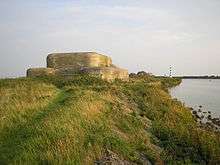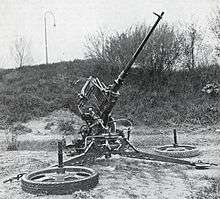Battle of the Afsluitdijk
| ||||||||||||||||||||||||||||
The Battle of the Afsluitdijk was an unsuccessful attempt by the German Army to seize the Afsluitdijk in May 1940, during World War II. If the Germans had taken the dam, they could have taken North Holland from its north. The Dutch troops were led by Captain Christiaan Boers and the Germans by General Kurt Feldt.
Fortifications and preparations
Germany invaded the Netherlands on 10 May 1940 as part of plan Fall Gelb. They rapidly crossed two thin defence lines, the O-line and the Q-line, which the Dutch had built to defend their three northern provinces.

The German 1st Cavalry Division—later reformed to the 24. Panzerdivision—had taken the last Dutch defences in front of the Afsluitdijk (Wonsline) on 12 May and was prepared for an assault to take the two lines of pillboxes or casemates of Fort Kornwerderzand (named after a hamlet near the dyke). The eastern line was for defence eastward, while the western line was just behind the first for threats from the rear. Altogether, 17 casemates had been built. They were designed to withstand 210 mm (8 in) rounds (direct fire), and 280 mm (11 in) rounds (indirect fire). The three main casemates were made of 3 m (9.8 ft) of reinforced concrete. The casemates sheltered 230 men, twenty-one 7.9 mm (0.311 in) Schwarzlose machine guns, three 50 mm (1.97 in) guns and a 50 mm shore-based naval gun. There were similar defences at the other end of the dyke.
Battle
Earlier in May 1940, two infantry sections—70 men in all—were sent to the end of the dyke to prevent German landings beyond the vision of both fortresses. The Germans soon found out about these units, and seven Luftwaffe fighters strafed Dutch positions. One soldier and two civilians were killed, and 10 civilians wounded. After this, they were recalled to Kornwerderzand.
Until 12 May, the Germans had not tried to take Fort Kornwerderzand. However, that evening, three soldiers were sent to see if the fort had been abandoned. They were pinned down by machine gun fire. Two were killed, while the third escaped. The Germans decided to take the fortress. They planned to launch Luftwaffe strikes, then begin an extended artillery bombardment by howitzers, after which they would send 500 soldiers.
However, unknown to the Germans, three 20 mm (0.79 in) anti-aircraft cannons and four heavy anti-aircraft machine guns had arrived overnight at Kornwerderzand.[3] The next day, pilots who had previously flown unchallenged were under fire. The Germans sent 62 planes to bomb the fort. The planes dropped five waves of bombs. Four planes were shot down and crashed into the sea. The bombardment was followed by an hour of heavy bombardment from the howitzers, but it had little effect on the heavily protected Dutch.

As soon as the bombing stopped, German shocktroops advanced down the narrow dyke on bicycles.[3] Boers waited until they were within 800 m (870 yd), then ordered machine-gun fire, making it difficult for the Germans to withdraw. Most soldiers tried to hide, while a few managed to advance. The Germans were under constant fire for an hour and 20 minutes. When Boers ordered firing to stop, the remaining Germans withdrew — the assault had failed. During the night Boers ordered the dyke to be lit by flares and search lights so the fortress could not be attacked by surprise.
On the early morning of the 14th, the Germans once again fired their artillery at the fortress; however, during the night the Dutch had called in the sloop HNLMS Johan Maurits van Nassau, which returned fire with her three heavy 150 mm (5.9 in) guns from her position in the Wadden Sea approximately 18 km (11 mi) from the German positions. Fire directions came in from the fortress by telephone to Dutch Navy Command in Den Helder who forwarded them by radiotelegraph to the gunboat. This barrage silenced the German guns in less than an hour and dumbfounded the German commander, General Kurt Feldt, who was unaware of the presence of any Dutch artillery in the area, let alone of such heavy caliber.
Casualties
Local civilians said hundreds of Germans were killed, and the dyke was filled with bodies. The German report says two were killed on the 12th and three on the 13th. The German wounded were officially around 25. The Dutch suffered one killed during the first attack by the Luftwaffe and two wounded during the bombing when two soldiers manning anti-aircraft guns were hit. Civilian casualties numbered at two killed, 10 wounded, all from the first Luftwaffe attack.
Aftermath
The fortress remained in Dutch hands until the surrender of Dutch forces on 15 May. Boers told the men that they had fought like lions but that in other parts of the country, their armies had been defeated. Boers himself led the surrender.
References
External links
Coordinates: 53°4′27″N 5°20′13″E / 53.07417°N 5.33694°E